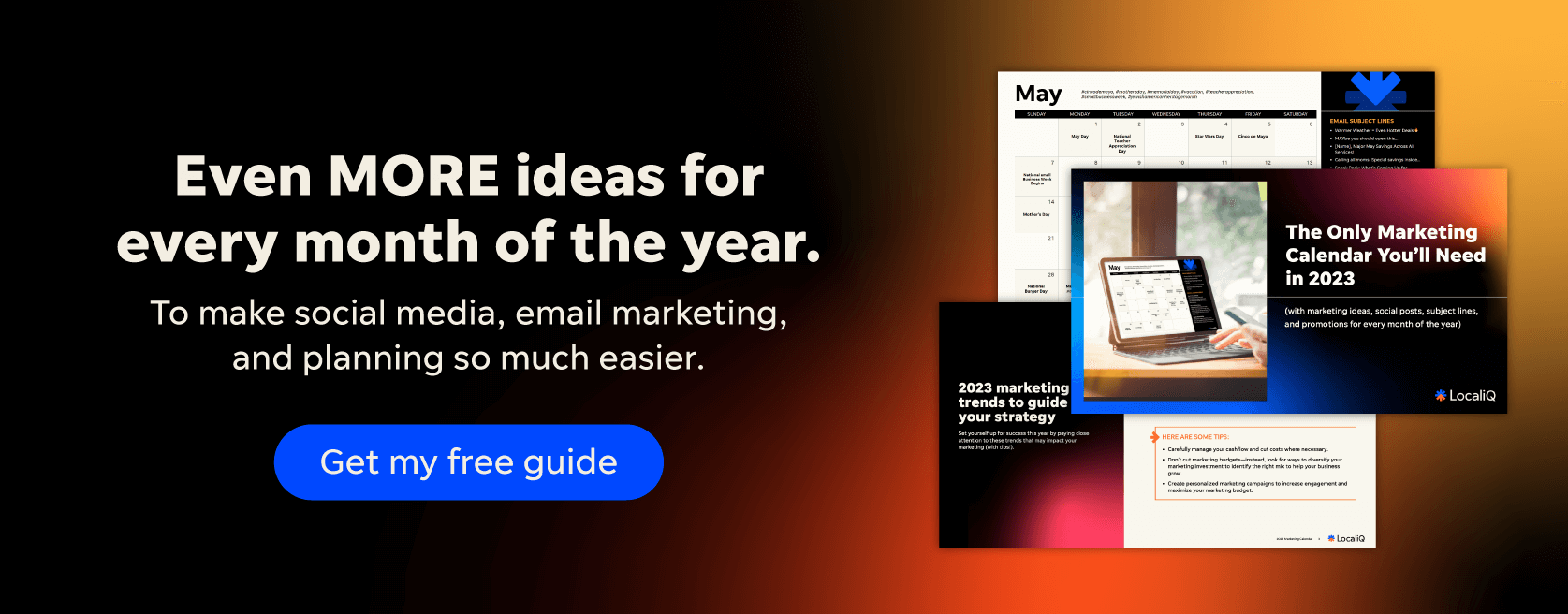Whether from a friend, family member, neighbor, or co-worker, recommendations from people we know and trust tend to carry more weight than those from people we don’t.
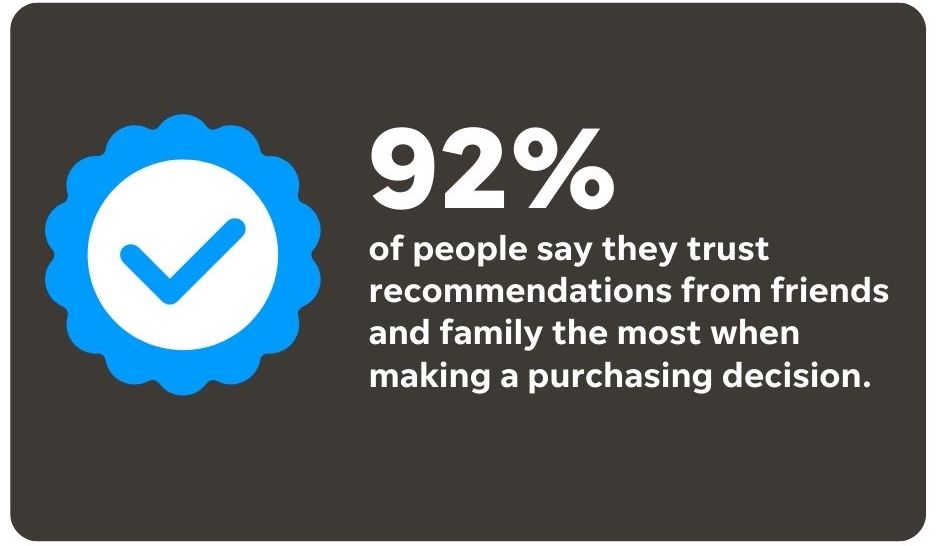
Think back to when you made a purchase based on a word-of-mouth recommendation from someone you know. Maybe it was your friend who told you about her favorite pizza place or your neighbor who recommended a local plumber.
You probably took those recommendations more seriously than an advertisement or commercial, didn’t you?
In today’s digital world, word-of-mouth marketing has become even more prevalent.
In this guide, we’ll explore what a word-of-mouth marketing strategy is, why it works, and how to encourage your customers to participate on behalf of your brand.
Table of contents
- What is word-of-mouth marketing?
- How does word-of-mouth marketing work?
- Word-of-mouth marketing strategies and examples
What is word-of-mouth marketing?
From the consumer perspective, word-of-mouth (WOM) marketing is when one person tells another about a product or service. This can be done in person or online.
Word-of-mouth marketing is the hardest marketing strategy to implement. Why? Because it happens at the hands of your customers. But for this reason, it’s arguably the most powerful strategy because it comes from a trusted source who has had a personal experience with you—your customers.
How does word-of-mouth marketing work?
We’ve all participated in word-of-mouth marketing. When you go to a restaurant and have an amazing experience, you tell your friends about it. When your colleagues ask you where you got a new shirt, you tell them where you bought it.
This is word-of-mouth marketing. It happens every day between friends, family members, and co-workers. You can’t beat the authenticity of hearing about a product or service from someone you know and trust.
While people share negative experiences more frequently than positive ones, they are still sharing positive experiences regularly–and with a variety of people. And you want them to share their positive experience with your business in these ways as well.

As a business, to reverse-engineer word-of-mouth marketing, you must build trust with your audience and deliver an excellent customer experience. Customers who don’t trust you or who didn’t have a stand-out experience with your business won’t share your brand with their friends and family.
While word-of-mouth marketing doesn’t cost businesses anything to implement—sharing good experiences with friends and family is free—it does cost brands to build that trust with their customers. High-quality products and services, customer service and success teams, thoughtful and creative advertising–all of these involve investments that pay off through word-of-mouth marketing.
7 word-of-mouth marketing strategies (with examples)
Want to get new customers and build your presence through word-of-mouth marketing? Try these strategies to help.
1. Ask for customer testimonials and use social proof to build credibility for your business
79% of shoppers find online reviews as trustworthy as personal recommendations. That’s a huge deal!
Customer testimonials build credibility and trust with potential clients. One of the most effective ways to do this is by asking satisfied customers for reviews or testimonials that you can use on your website, on social media, or in your marketing collateral.
Make it as easy as possible for your happy customers to sing your praises and share their experiences with their network:
Ask for customer testimonials. Use a tool like SurveyMonkey and ask customers to complete a survey about their experience with your company. Ask those who share positive feedback if you can use it as part of your marketing efforts. (If you receive any negative comments, be sure to address those, too.)
Add social proof to your website. Use a tool like Yelp or Google Customer Reviews to get ratings and reviews on your business and display them on your website. (Use our tips to help you get more Google reviews.)
Add sharing buttons on your e-commerce site. Ensure customers can rave about your products on social media so you can share them on your brand channels.
Get specific. Instead of asking your customer, “How was your experience with us?” ask them specific questions like “What was your favorite part of our service?” or “How did we help you save time or money?”
Here’s how Michelle Schroeder-Gardner—a popular personal finance blogger—includes testimonials from real students on her website.

Michelle also encourages other bloggers to review her course on their own blogs and social media channels. Her positive experiences, followed by the power of word-of-mouth and a successful launch, have helped her attract new leads and convert them into $434,698 in course sales.
2. Reward advocates for referrals
Contagious enthusiasm and positive word-of-mouth is the most powerful form of advertising in the world. But, how do you encourage your customers to talk about you?
That’s where incentive-based referral programs come in. Incentivize customers to make referrals that convert into new business.
That said, referral marketing isn’t just a tool to incentivize customers to share the word about your brand. It’s also a way to create a sense of community around your business and give people another reason to remain loyal customers.
Popular referral programs include:
- Referral credits. Customers receive a credit toward their next purchase for referring new leads or customers.
- Customer loyalty points. Points are accumulated over time and can be used for future purchases or exchanges for other products or services.
- Discount codes or coupons. Customers can share their codes with friends and family, who in turn get discounts on their first orders (and give the referrer a discount, too).
Here’s an example of an effective referral program by Deel, a payroll and compliance platform.

This incentive encourages Deel customers to refer friends and family. In turn, they earn a $200 Amazon gift card for every person that signs up.
3. Make outstanding customer service a priority
Great customer service is a business’s best marketing tactic. In addition to attracting new customers, it keeps existing ones coming back.
Customer satisfaction matters because happy customers are more likely to refer others to your business. 69% of people would recommend the business to others after a satisfactory customer experience. They might also express their experience on their social channels.

Word-of-mouth marketing can harness negative customer experiences, too.
While good customer service encourages your customers to rave about you on their social media, bad customer service will do the exact opposite. The latter can lead to damage to your brand’s reputation. A simple Twitter search will show you hundreds of instances of negative word-of-mouth.
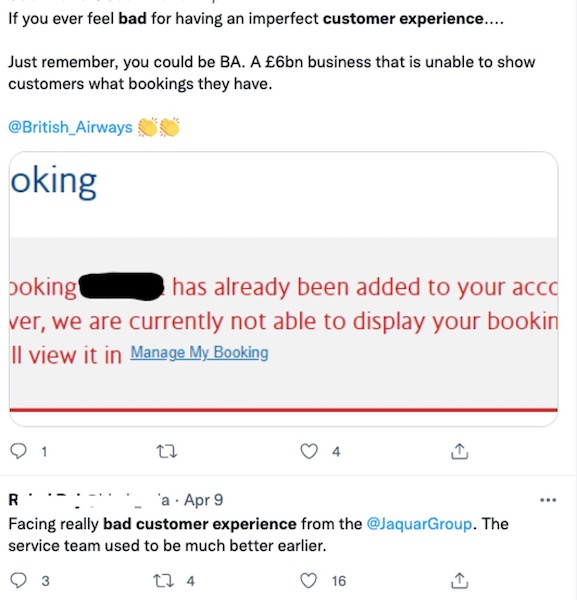
To provide your customers with excellent service, communicate promptly and clearly with them when something goes wrong, and offer fair compensation if necessary. Customers who feel their complaints are being taken seriously will be less likely to seek satisfaction elsewhere.
Get more tips on how to respond to negative reviews and complaints here.
4. Leverage influencer marketing
Influencer marketing is a powerful tool for small businesses because it enables you to tap into the following of an industry expert and potentially reach thousands of new customers.
You partner with a person who has a built-in audience that trusts their brand recommendations for their purchasing decisions.
Influencers who positively talk about your brand will have a ripple effect on consumer perception. Your goal is to leverage their influence to sell your product.
Here’s how Häagen-Dazs, an American ice cream brand, partnered with millennial lifestyle influencers in NYC to highlight their “buy one, get one free” promotion. They encouraged influencers to share posts hosting summer parties and sampling events on Pinterest, Facebook, and Twitter with an air of New York City in the summertime.

Some content creators were even invited to host the #HDOpenContainer Instagram Challenge to encourage the target audience to stop by select sampling events and show off the free single serves they received.
As a result, the campaign garnered over 14.3 million impressions (43% above the goal) and 27,400 engagements on social media.
Similarly, Red Bull leveraged the power of influencer marketing to cultivate a tribe of ambassadors for its Brand Ambassador Program, Wings Team. They sought influencers who were considered “opinion leaders” in their communities or were well-liked and trusted by their peers.
Their team then provided these influencers with products, access to exclusive events, and other opportunities.

In return, they asked that the Wings team members “create and share great content” and give a shoutout to Red Bull to build a brand identity and connect with potential consumers.
5. Create shareable content
Shareable content encourages your audience and customers to spread the word about your business, thus gaining new leads and increasing conversion rates.
This type of content often includes a blog post or video that people want to share with others because it contains valuable information, unique insights, statistics, and more. It’s typically a blend of insightful and entertaining.
Here are some other tips for creating shareable content:
- Create something new. Break the news on a topic or create an original piece of research that others can link back to.
- Make it visual. Visuals are more likely to be shared because they’re easier to digest and take up less space in someone’s feed.
- Make it emotional. Whether this means making someone laugh or tugging at their heartstrings, creating emotional connections is key for getting shares.
- Be genuine. People will only share something if they think what you’re saying is authentic and adds value to their communities.
You can also run campaigns to scout user-generated content (UGC) from your customers. A smart way to do this is by running a contest—something that incentivizes people to mention your brand and share their own experiences about it.
Coca-Cola’s oft-repeated “Share a Coke” campaign is an excellent example.
One of the most ambitious campaigns in recent years, Coca-Cola’s Share a Coke campaign, not only saw cans and bottles of coke adorned with people’s names but also encouraged people to share their own bottles by posting photos on their social networks.
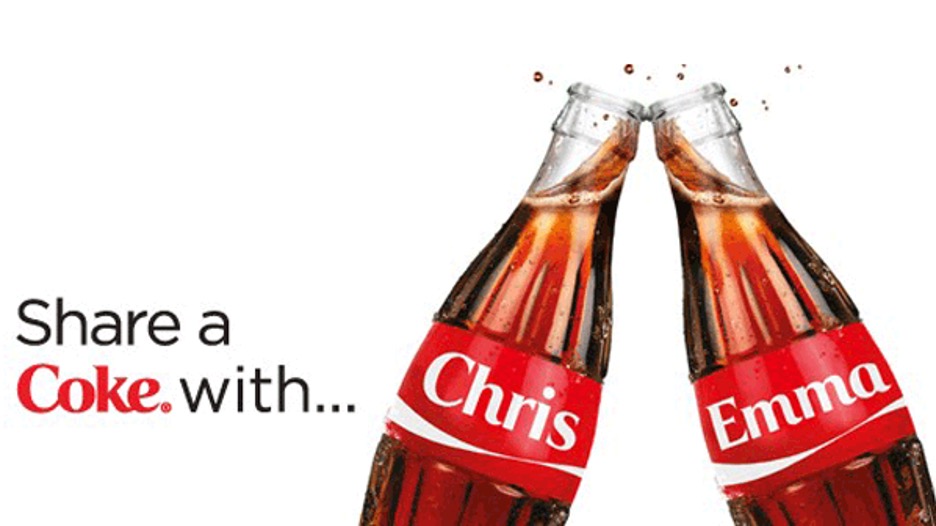
The campaign was a huge success, with Coca-Cola receiving tons of shares and helping the company deepen its connection with customers—leading to increased sales and brand loyalty.
6. Give customers a story to tell
To encourage customers to spread the word about your brand or a new product, you have to “give them a story to tell” and “give readers a system for doing word-of-mouth on purpose, ” says marketing and customer experience expert Jay Baer.
Authentic customer stories go a long way for word-of-mouth marketing. If you want to encourage customers to share their experiences, give them a story to tell.
However, providing customers with a positive experience is not enough to get them talking about your company online and in person. They must have something more than just great products or services. Provide them with a memorable experience, and you’ll earn their loyalty for life.
For example, DoubleTree hotels provide a warm chocolate chip cookie for free every time a guest checks into their hotel. Jay Baer talked to hundreds of DoubleTree guests to discover that about 34% of the customers had mentioned that experience to someone else in their network.
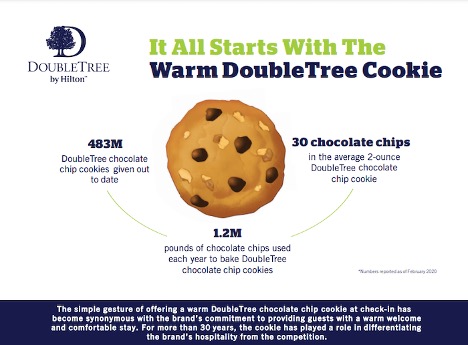
To create similar customer experiences, you need to first understand your customers, where they are, and what they want.
Start by creating buyer personas—fictional representations of your ideal customer based on real data about your existing customers and target audience. Your personas should include customer demographics, behavior patterns, motivations, and goals. Use these personas to inspire special experiences that will encourage customers to share your brand with their friends.
Related: Not sure where to start with your buyer personas? Check out these target market examples for inspiration.
7. Sponsor or host events
Hosting or sponsoring events that target your specific audience is a great way to increase brand awareness and promote your products while garnering the potential for word-of-mouth marketing.

Enjoyable events, both in-person and virtual, can help customers associate good feelings with your brand. This is also an opportunity for potential customers to discover your business for the first time.
If you’re not sure what to sponsor or host, consider your buyer personas, the experiences they enjoy, and the causes they care about. For example, if you sell artisanal cheeses, cheese tastings would be an ideal way to promote your brand.
Word-of-mouth is the word
With these best practices, get started with your word-of-mouth marketing strategy. Building a word-of-mouth marketing strategy can help you drive more leads and sales as well as deepen your connection with your existing customers. Remember that incredible customer service is the best marketing and best determinant of a successful word-of-mouth marketing strategy. So focus on delivering excellent customer service, high-quality products and services, and consistent branding to elevate the customer experience and foster word-of-mouth with your customers.

